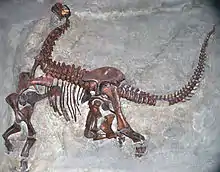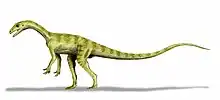Camarasauridae
Camarasauridae is a family of sauropod dinosaurs.[1] Among sauropods, camarasaurids are small to medium-sized, with relatively short necks. They are visually identifiable by a short skull with large nares, and broad, spatulate teeth filling a thick jaw.[2][3] Based on cervical vertebrae and cervical rib biomechanics, camarasaurids most likely moved their necks in a vertical, rather than horizontal, sweeping motion, in contrast to most diplodocids.[2]
| Camarasaurids Temporal range: Late Jurassic to Early Cretaceous, | |
|---|---|
 | |
| Skeleton of Camarasaurus | |
| Scientific classification | |
| Domain: | Eukaryota |
| Kingdom: | Animalia |
| Phylum: | Chordata |
| Clade: | Dinosauria |
| Clade: | Saurischia |
| Clade: | †Sauropodomorpha |
| Clade: | †Sauropoda |
| Clade: | †Neosauropoda |
| Clade: | †Macronaria |
| Clade: | †Camarasauromorpha |
| Family: | †Camarasauridae Cope, 1877 |
| Type genus | |
| †Camarasaurus Cope, 1877 | |
| Genera | |
| Synonyms | |
| |
Taxonomy
Camarasauridae was named by Edward Drinker Cope in 1877. Its type genus is Camarasaurus, and it is defined as the clade containing all species more closely related to Camarasaurus supremus than Saltasaurus loricatus.[4]
Phylogenetic relationships
Camarasauridae is typically regarded as belonging to Macronaria, one of the two major branches of Neosauropoda. Within Macronaria, it occupies a basal position, outside of Titanosauriformes. However, some studies have found Camarasauridae to lie outside Neosauropoda.[5]
Members
Camarasaurus is the only taxon uncontroversially regarded as a valid genus of camarasaurid. It contains four species: C. grandis, C. lentus, C. lewisi, and C. supremus. C. lewisi may represent a distinct genus, Cathetosaurus.[6] Lourinhasaurus, the type species of which was formerly assigned to Camarasaurus, is regarded as a camarasaurid by most studies,[7][5] though it has also been considered to be a basal eusauropod.[8]
Oplosaurus, from the Early Cretaceous of the United Kingdom, has been suggested to be a camarasaurid,[9] but as it is only known from a tooth, its position within Eusauropoda is difficult to determine.[10] Tehuelchesaurus, from the Late Jurassic of Argentina, has been considered a camarasaurid in some studies,[7][11] but a wide range of other phylogenetic positions have been proposed, including a close relationship to Omeisaurus,[8] a position in Turiasauria,[5] or as a non-camarasaurid basal macronarian.
Bellusaurus, which is only known from juvenile remains, may be a camarasaurid,[12] though it has also been considered a basal macronarian, turiasaur, or mamenchisaurid.[5][11]
A possible camarasaurid of indeterminate genus and species was reported from the Middle Jurassic of India.[13]
Former members
In 1970, Rodney Steel took an expansive concept of Camarasauridae, encompassing all sauropods then known except diplodocoids and titanosaurs.[14] In 1990, John S. McIntosh regarded Camarasauridae as made up of two subfamilies: Camarasaurinae, containing Camarasaurus, Aragosaurus, Euhelopus, and Tienshanosaurus, and Opisthocoelicaudiinae, containing Opisthocoelicaudia and Chondrosteosaurus.[15] Dashanpusaurus, from the Middle Jurassic of China, was originally described as a camarasaurid,[16] but was subsequently found to be a basal macronarian by phylogenetic analysis.[17]
Diagnostic characters
Several skeletal features have been used to characterize the camarasaurids. In the skull, these include an external narial diameter approximately 40% of the long-axis length of the skull, an arched internarial bar, a short muzzle anterior to the nares, and maxillary shelf.[18] In the rest of the axial skeleton, these include flat ventral faces on the cervical vertebrae, a triangular flare to the neural spines of the middle and posterior dorsal vertebrae, and a concave posterior surface to the anterior thoracic ribs, as well as an external haemal canal across the anterior vertebrae of the tail.[18][19] A reduction to two carpals, long metacarpals relative to the radius, and a twisted ischial shaft serve to identify the appendicular skeleton.[2][19]
Palaeobiogeography
Broadly speaking, camarasaurids occupied a distribution limited to the Laurasian continent during the Upper Jurassic.[18] Most currently accepted camarasaurid specimens have been discovered in the Morrison Formation of North America, however some specimens from the African Tendaguru Formation have been speculated to belong to the genus Camarasaurus, and the closely related Lourinhasaurus was found in Portugal.[20][21][22]
References
- 1. Taylor, M. P., & Naish, D. (2005). The phylogenetic taxonomy of Diplodocoidea (Dinosauria: Sauropoda). Museum of Paleontology, University of California, Berkeley.
- 1. Weishampel, D. B., Dodson, P., & Osmólska, H. (Eds.). (1990). The dinosauria. Univ of California Press.
- Coombs, Walter P. (February 1975). "Sauropod habits and habitats". Palaeogeography, Palaeoclimatology, Palaeoecology. 17 (1): 1–33. Bibcode:1975PPP....17....1C. doi:10.1016/0031-0182(75)90027-9. ISSN 0031-0182.
- Taylor, M. P.; Naish, D. (November 2007). "An Unusual New Neosauropod Dinosaur from the Lower Cretaceous Hastings Beds Group of East Sussex, England". Palaeontology. 50 (6): 1547–1564. Bibcode:2007Palgy..50.1547T. doi:10.1111/j.1475-4983.2007.00728.x. ISSN 0031-0239.
- Mannion, Philip D.; Upchurch, Paul; Schwarz, Daniela; Wings, Oliver (2019-02-27). "Taxonomic affinities of the putative titanosaurs from the Late Jurassic Tendaguru Formation of Tanzania: phylogenetic and biogeographic implications for eusauropod dinosaur evolution". Zoological Journal of the Linnean Society. 185 (3): 784–909. doi:10.1093/zoolinnean/zly068. eISSN 1096-3642. hdl:10044/1/64080. ISSN 0024-4082.
- Tschopp, Emanuel; Maidment, Susannah C.R.; Lamanna, Matthew C.; Norell, Mark A. (2019-11-04). "Reassessment of a Historical Collection of Sauropod Dinosaurs from the Northern Morrison Formation of Wyoming, with Implications for Sauropod Biogeography". Bulletin of the American Museum of Natural History. 2019 (437): 1. doi:10.1206/0003-0090.437.1.1. ISSN 0003-0090. S2CID 207890316.
- Mocho, Pedro; Royo-Torres, Rafael; Ortega, Francisco (2014). "Phylogenetic reassessment of Lourinhasaurus alenquerensis, a basal Macronaria (Sauropoda) from the Upper Jurassic of Portugal". Zoological Journal of the Linnean Society. 170 (4): 875–916. doi:10.1111/zoj.12113. ISSN 0024-4082.
- Upchurch, Paul; Barrett, Paul M.; Dodson, Peter (2004). "Sauropoda". In Weishampel, David B.; Dodson, Peter; Osmólska, Halszka (eds.). The Dinosauria (2 ed.). Berkeley: University of California Press. pp. 259–322. ISBN 0-520-24209-2.
- Canudo, José Ignacio; Ruiz-Omeñaca, José Ignacio; Barco, José Luis (2002). "¿Saurópodos asiáticos en el Barremiense inferior (Cretácico Inferior) de España?". Ameghiniana. 39 (4): 443–452.
- Upchurch, Paul; Mannion, Philip D.; Barrett, Paul M. (2011). "Sauropod dinosaurs". Field Guide to English Wealden Fossils. London. pp. 476–525.
{{cite book}}: CS1 maint: location missing publisher (link) - Moore, Andrew J.; Upchurch, Paul; Barrett, Paul M.; Clark, James M.; Xu, Xing (2020-05-28). "Osteology of Klamelisaurus gobiensis (Dinosauria, Eusauropoda) and the evolutionary history of Middle–Late Jurassic Chinese sauropods". Journal of Systematic Palaeontology. 18 (16): 1299–1393. doi:10.1080/14772019.2020.1759706. eISSN 1478-0941. ISSN 1477-2019. S2CID 219749618.
- Lacovara, Kenneth J.; Ibiricu, L.M.; Lamanna, M.C.; Poole, J.C.; Schroeter, E.R.; Ullmann, P.V.; Voegele, K.K.; Boles, Z.M.; Egerton, V.M.; Harris, J.D.; Martínez, R.D.; Novas, F.E. (2014-09-04). "A gigantic, exceptionally complete titanosaurian sauropod dinosaur from southern Patagonia, Argentina". Scientific Reports. 4: 6196. doi:10.1038/srep06196. PMC 5385829. PMID 25186586.
- Moser, Markus; Mathur, Umesh B.; Fürsich, Franz T.; Pandey, Dhirendra K.; Mathur, Neera (2006-03-31). "Oldest camarasauromorph sauropod (Dinosauria) discovered in the middle jurassic (Bajocian) of the Khadir Island, Kachchh, western India". Paläontologische Zeitschrift. 80 (1): 34–51. doi:10.1007/BF02988396. ISSN 0031-0220. S2CID 129725762.
- Steel, Rodney (1970). Saurischia. Handbuch der Paläoherpetologie. Stuttgart: Gustav Fischer Verlag.
- McIntosh, J. S. (1990). "Sauropoda". In Weishampel, David B.; Dodson, Peter; Osmólska, Halszka (eds.). The Dinosauria (1 ed.). Berkeley: University of California Press. pp. 345–401.
- Peng, G.; Y. Ye; Y. Gao; C. Shu; S. Jiang (2005). Jurassic Dinosaur Faunas in Zigong. Chengdu: Sichuan Publishing Group People's Press. ISBN 7-220-07051-9.
- Ren, Xin-Xin; Jiang, Shan; Wang, Xu-Ri; Peng, Guang-Zhao; Ye, Yong; Jia, Lei; You, Hai-Lu (2022-11-14). "Re-examination of Dashanpusaurus dongi (Sauropoda: Macronaria) supports an early Middle Jurassic global distribution of neosauropod dinosaurs". Palaeogeography, Palaeoclimatology, Palaeoecology. 610: 111318. doi:10.1016/j.palaeo.2022.111318. ISSN 0031-0182.
- Upchurch, Paul (1995-09-29). "The evolutionary history of sauropod dinosaurs" (PDF). Phil. Trans. R. Soc. Lond. B. 349 (1330): 365–390. doi:10.1098/rstb.1995.0125. ISSN 0962-8436.
- Wilson, J. A., & Sereno, P. C. (1998). Early evolution and higher-level phylogeny of sauropod dinosaurs. Journal of Vertebrate Paleontology, 18(S2), 1-79.
- FosteR, J. R., & Wedel, M. J. (2014). Haplocanthosaurus (Saurischia: Sauropoda) from the lower Morrison Formation (Upper Jurassic) near Snowmass, Colorado. Volumina Jurassica, 12(2), 197-210.
- Foster, J. R., & Lucas, S. G. (Eds.). (2006). Paleontology and Geology of the Upper Jurassic Morrison Formation: Bulletin 36(Vol. 36). New Mexico Museum of Natural History and Science.
- Raath, J. S. (1987). Sauropod dinosaurs from the Central Zambezi Valley, Zimbabwe, and the age of the Kadzi Formation. South African Journal of Geology, 90(2), 107-119.










